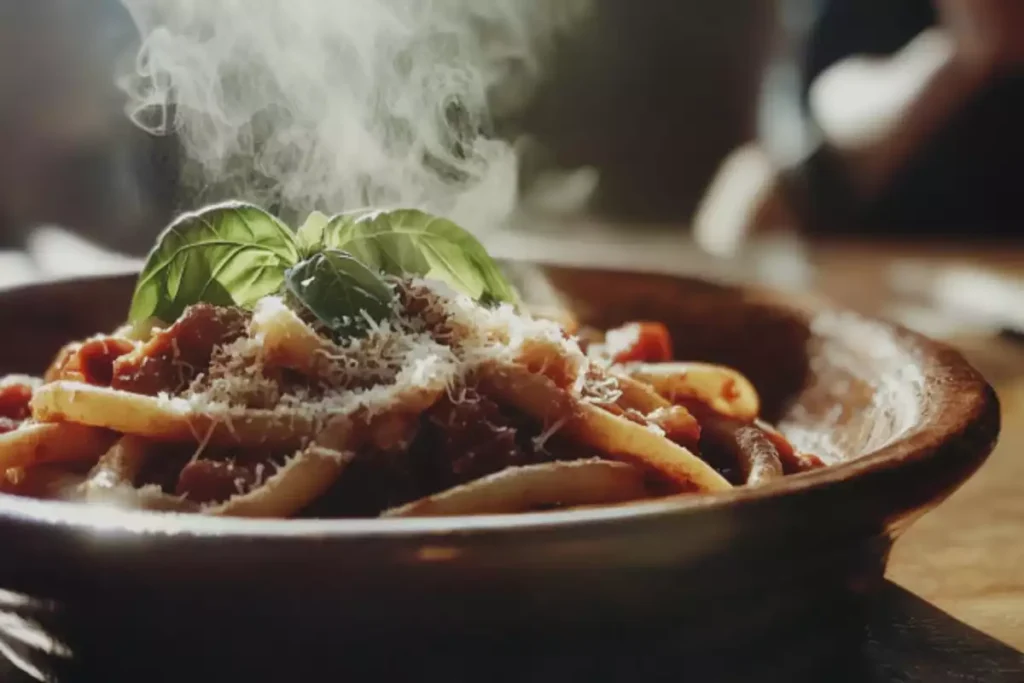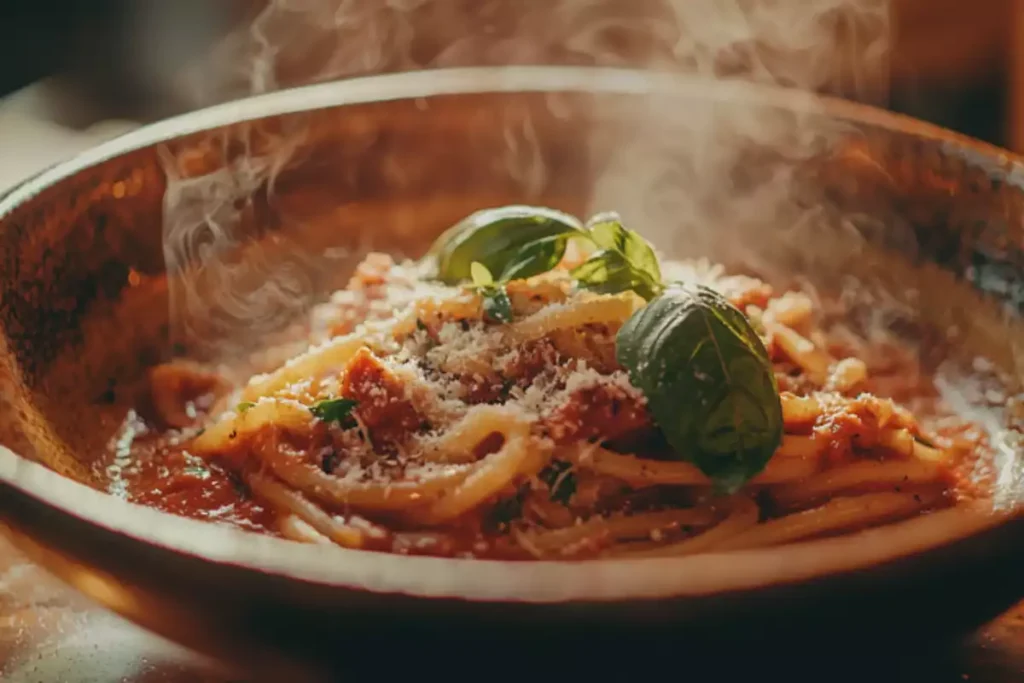
Bucatini is a pasta variety loved for its unique structure and versatility in the kitchen. This hollow, spaghetti-like pasta is ideal for capturing sauces and adding texture to dishes. But what exactly is bucatini best used for? In this article, we’ll explore its traditional uses, creative applications, and the best tips for cooking it to perfection. Whether you’re a seasoned chef or a home cook, this guide will inspire you to make the most of bucatini.
What Makes Bucatini Unique?
Bucatini stands out among other pasta types due to its hollow center, which runs the length of each strand. This feature allows it to hold sauces inside while coating the outside, delivering a burst of flavor in every bite. Its slightly thicker structure also means it holds up well to hearty and rich sauces, making it a favorite in Italian kitchens.
Traditional Uses for Bucatini
1. Bucatini all’Amatriciana
One of the most famous dishes featuring bucatini is Bucatini all’Amatriciana. Originating in Rome, this recipe combines bucatini with a spicy tomato sauce made from guanciale (cured pork cheek), Pecorino Romano cheese, and red pepper flakes. The pasta’s hollow center perfectly traps the savory sauce, making each bite unforgettable.
2. Bucatini with Carbonara Sauce
Although spaghetti is the classic choice for Carbonara, bucatini offers a delightful twist. Its hollow structure captures the creamy, egg-based sauce, ensuring a rich and indulgent meal. The added texture from bucatini enhances this Roman favorite.
3. Cacio e Pepe
Bucatini works wonderfully in Cacio e Pepe, a simple dish featuring Pecorino Romano cheese and black pepper. The pasta’s thick and sturdy nature helps it hold onto the cheesy, peppery sauce.
Creative Applications for Bucatini
Bucatini’s versatility extends beyond traditional recipes. Its unique structure makes it perfect for:
1. Soups and Stews
Bucatini adds heartiness to soups, absorbing the broth’s flavors while retaining its shape. Use it in minestrone or chicken noodle soup for an elevated experience.
2. Baked Bucatini
In baked pasta dishes, bucatini shines. Its hollow center allows the pasta to soak up the flavors of marinara or béchamel sauce. Layer it with mozzarella and Parmesan for a gooey, satisfying dish.
3. Oil-Based Sauces
Aglio e Olio (garlic and olive oil) and bucatini are a match made in heaven. The pasta’s texture contrasts beautifully with the simplicity of the sauce, making it a go-to choice for quick, flavorful meals.
4. Cold Pasta Salads
Bucatini can bring a new dimension to pasta salads. Its shape holds light dressings, like lemon vinaigrette, while complementing ingredients like fresh vegetables, olives, and feta cheese.

Tips for Cooking Bucatini
1. Cook Al Dente
Due to its thickness, bucatini takes slightly longer to cook than regular spaghetti. Aim for al dente to ensure it retains its structure and doesn’t become mushy.
2. Reserve Pasta Water
The starchy water left after cooking bucatini is perfect for emulsifying sauces. Always save a cup to achieve a creamy, cohesive texture in your dishes.
3. Use Generous Sauces
Because of its hollow center, bucatini works best with thick or flavorful sauces that can fill and coat the pasta. Don’t shy away from bold flavors!
Pairing Bucatini with Ingredients
Best Sauces
- Tomato-based sauces: Amatriciana, marinara, or arrabbiata.
- Cream-based sauces: Alfredo, Carbonara, or a mushroom cream sauce.
- Oil-based sauces: Pesto, olive oil with garlic, or a simple herbed butter.
Proteins
- Meat: Guanciale, pancetta, or sausage.
- Seafood: Clams, shrimp, or anchovies.
- Vegetarian: Roasted vegetables like zucchini, eggplant, or bell peppers.
Cheeses
Grated hard cheeses like Pecorino Romano or Parmesan pair beautifully with bucatini. For creamy textures, consider ricotta or mascarpone.
Popular Bucatini Recipes
Bucatini all’Amatriciana
Ingredients:
- 400g bucatini
- 150g guanciale, diced
- 1 can (400g) San Marzano tomatoes
- 50g Pecorino Romano, grated
- 1 tsp chili flakes
- 1 tbsp olive oil
- Salt and pepper to taste
Instructions:
- Cook guanciale in olive oil until crispy. Set aside.
- Add chili flakes to the pan and sauté briefly. Add tomatoes and simmer for 15 minutes.
- Cook bucatini in salted water until al dente. Reserve pasta water.
- Toss bucatini with sauce, adding pasta water if needed. Top with guanciale and Pecorino Romano.
Creamy Bucatini Carbonara
Ingredients:
- 400g bucatini
- 150g pancetta, diced
- 2 large eggs
- 1 cup Parmesan cheese, grated
- Salt and pepper to taste
Instructions:
- Whisk eggs and Parmesan in a bowl.
- Cook pancetta until crispy.
- Cook bucatini al dente. Toss with pancetta and egg mixture, using pasta water to create a creamy sauce.
Frequently Asked Questions
1. Can I Use Bucatini Instead of Spaghetti?
Yes! Bucatini can replace spaghetti in most recipes, especially where a thicker, more substantial pasta is desired.
2. Is Bucatini Gluten-Free?
Traditional bucatini is made with wheat, but gluten-free versions are available, crafted from rice, corn, or quinoa flour.
3. What Dishes Are Best for Bucatini?
Bucatini shines in dishes with rich sauces, soups, and baked casseroles. Its hollow center makes it versatile for both traditional and creative recipes.
4. How Do I Store Leftovers?
Store cooked bucatini in an airtight container in the refrigerator for up to three days. Reheat with a splash of water or sauce to restore moisture.
5. What Makes Bucatini Hard to Find?
Bucatini experienced a brief shortage in the U.S. due to import issues, but it is now widely available in most grocery stores and online.
Conclusion
Bucatini is a pasta lover’s dream, offering unparalleled versatility and flavor. Whether you’re making a classic Amatriciana, experimenting with baked dishes, or creating a refreshing pasta salad, bucatini’s hollow structure elevates every recipe. Now that you know what bucatini is best used for, it’s time to get cooking and enjoy this culinary gem.